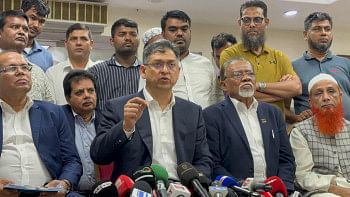Once a lifeline, Shibsa river fades into a stream

Once a thriving artery of communication in the Khulna region, the Shibsa River is now a shadow of its former self. In the past, it was navigated by large boats, ships, launches, and steamers. The river connected Khulna with Kolkata.
In recent decades, however, this vital waterway has been in decline. Waterlogging has become a persistent issue in areas along the river due to the drying up of canals.
Once, water from Tala and Satkhira Sadar used to flow out through the Shibsa. But over the past 20 years, that flow has all but ceased, causing prolonged waterlogging in large parts of Tala and Satkhira Sadar upazilas.
The stretch of the Shibsa that flows into the Sundarbans still functions as an inland waterway and remains part of the sea route under the Bangladesh-India Naval Protocol. But just east of Paikgachha upazila Sadar, near the Shibsa Bridge, the river has withered to a narrow trickle.
The mighty current that once surged under the bridge has vanished, and during high tide, only a small stream offers a faint reminder of its past.
This dried-up condition spans roughly 27 kilometres of the river as it flows through Paikgacha. From there, the Shibsa continues eastward through Soladana and Garuikhali before entering the Sundarbans and merging with the Pasur River. Further downstream, the river branches off again before emptying into the Bay of Bengal as the Kuda River.
Though the 64-kilometre stretch of the river running through the Sundarbans still receives tidal water, heavy siltation is rapidly reducing its depth. Structures have cropped up on the dried sections, and people now cross the former riverbed on foot. The total length of the Shibsa is approximately 100 kilometres.
Mizanur Rahman, a 73-year-old retired schoolteacher from Paikgacha's Sona Potti, said, "Launches and other vessels used to carry goods from Khulna city to other upazilas. Locals depended on the river for almost every aspect of life."
Torab Ali, a fisherman from Soladana, said the community now sees very few fish in the river. "Many fishermen in my village have had to change professions," he added.
A recent visit to the river basin near Paikgacha Bridge revealed a nearly dry riverbed with only a faint current.
Around a hundred ponds and various structures have been built by villagers along its banks. The eight-kilometre stretch from Shibbati to Soladana is now entirely dry.
Professor Hashem Ali Fakir, a river researcher, said the Shibsa is now dying due to siltation caused by polder systems built in the 1960s. "The northern part of the river in Paikgachha upazila has almost dried up. The rate of sedimentation is very high in the southern section flowing into the Sundarbans," he said.
"To save the rivers of the south-western region, implementing Tidal River Management (TRM) is essential. This method helps restore the natural flow of tidal water, reduces waterlogging, and enhances soil fertility. Without TRM, the rivers will continue to silt up, leading to severe environmental and socio-economic consequences for local communities."
Dilip Kumar Dutta, former professor of environmental science at Khulna University, said coastal embankments have cut off floodplains from the river, halting natural sedimentation processes.
"This has hindered land formation in the region, which is part of the lower Gangetic Delta and still geologically immature. Settlement and river management activities were implemented before land formation was complete. Now the river has lost its existence and put us in danger," he said.

 For all latest news, follow The Daily Star's Google News channel.
For all latest news, follow The Daily Star's Google News channel. 





Comments